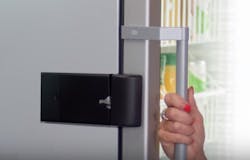In a perfect world, technology would work together no matter what. The manufacturer, age of equipment and software upgrade wouldn't matter. Unfortunately, when dealing with micro market coolers, this isn't always a reality. This is what has led Brian Arnold, maintenance supervisor for Arnold Vending to find the ideal aftermarket lock and install it on every Arnold Vending micro market cooler.
Original coolers didn't have locks
"Six or seven years ago the micro market coolers didn't have a health lock," explained Arnold. A health lock, also called an automatic, self-locking mechanism, ensures the food cooler or freezer will lock out consumers if the internal temperature rises too high for too long. "We bought the first health lock when it became available, but it wasn't a great fit," continued Arnold. "Consumers wouldn't realize the cooler was locked and would break the actuator on it when they pulled to open the cooler."
Too much inventory with different locks
Fast forward, and Arnold has seen a locking revolution in the industry. There are multiple aftermarket locks available as well as factory-installed locks. Each manufacturer has a locking mechanism unique to their cooler, and even freezer. Arnold started ordering coolers with built-in locks and was thrilled that he could ensure food safety and quality to Arnold Vending consumers. Unfortunately, it wasn't long before Arnold realized having some aftermarket locks on older coolers as well as a mix of coolers and freezers with proprietary locks resulted in a lot of different parts to keep in stock across their 60 micro market locations.
"There are three or four different types of coolers or freezers, and each have their own parts," said Arnold. "We had to carry acuators, control boards, etc. for each one. It was a hassle." The locks didn't all perform the same either. Arnold found some would break more easily or were more sensitive to humidity at locations.
Arnold decided it would be better for the company to choose a reliable lock that could be installed on any cooler or freezer. He chose TriTeq FreshIQ, which checked all his must-haves as well as offered remote monitoring of temperatures. Now the internal parts are all the same, with just a few shims needed when installing the aftermarket lock on a few brand-specific coolers. "It was really pretty simple – have a universal solution and you only need those parts," said Arnold. It even helps health inspectors. "It is less complicated for health inspections as they only have to know how to trip one type of lock," explained Arnold. "Each brand/manufacturer has their own procedure."
Operators should consider the advantages of implementing a common lock across all cooler and freezer manufacture models, instead of purchasing and learning how to maintain and trip different versions of factory-installed locks for each manufacturer.





